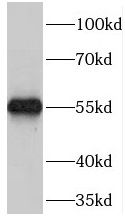Products
MASP1 antibody
| Synonyms: | Mannan-binding lectin serine protease 1|Complement factor MASP-3|Complement-activating component of Ra-reactive factor|Mannose-binding lectin-associated serine protease 1 (MASP-1)|Mannose-binding protein-associated serine protease|Ra-reactive factor serine protease p100 (RaRF)|Serine protease 5|Mannan-binding lectin serine protease 1 heavy chain|Mannan-binding lectin serine protease 1 light chain|MASP1|CRARF|CRARF1|PRSS5 antibody | ||
| Catalogue No.: | FNab05021 | Reactivity: | Human |
| Host: | Rabbit | Tested Application: | ELISA, WB |
| Clonality: | polyclonal | Isotype: | IgG |
| Size | Price |
|---|---|
| 100µg | Inquiry |
- SPECIFICATIONS
- FIGURES
- CONDITIONS
- FAQS
- Product Name
- MASP1 antibody
- Catalogue No.
- FNab05021
- Size
- 100μg
- Form
- liquid
- Purification
- Immunogen affinity purified
- Purity
- ≥95% as determined by SDS-PAGE
- Clonality
- polyclonal
- Isotype
- IgG
- Storage
- PBS with 0.02% sodium azide and 50% glycerol pH 7.3, -20℃ for 12 months(Avoid repeated freeze / thaw cycles.)
- Immunogen
- mannan-binding lectin serine peptidase 1(C4/C2 activating component of Ra-reactive factor)
- Alternative Names
- Mannan-binding lectin serine protease 1|Complement factor MASP-3|Complement-activating component of Ra-reactive factor|Mannose-binding lectin-associated serine protease 1 (MASP-1)|Mannose-binding protein-associated serine protease|Ra-reactive factor serine protease p100 (RaRF)|Serine protease 5|Mannan-binding lectin serine protease 1 heavy chain|Mannan-binding lectin serine protease 1 light chain|MASP1|CRARF|CRARF1|PRSS5 antibody
- UniProt ID
- P48740
- Observed MW
- 40-70 kDa
- Tested Applications
- ELISA, WB
- Recommended dilution
- WB: 1:500-1:2000
 HeLa cells were subjected to SDS PAGE followed by western blot with FNab05021( MASP1 Antibody) at dilution of 1:300
HeLa cells were subjected to SDS PAGE followed by western blot with FNab05021( MASP1 Antibody) at dilution of 1:300
- Background
- Functions in the lectin pathway of complement, which performs a key role in innate immunity by recognizing pathogens through patterns of sugar moieties and neutralizing them. The lectin pathway is triggered upon binding of mannan-binding lectin(MBL) and ficolins to sugar moieties which leads to activation of the associated proteases MASP1 and MASP2. Functions as an endopeptidase and may activate MASP2 or C2 or directly activate C3 the key component of complement reaction. Isoform 2 may have an inhibitory effect on the activation of the lectin pathway of complement or may cleave IGFBP5.
How many times can antibodies be recycled?
First, usually it's not suggested to recycle antibodies. After use, buffer system of antibodies has changed. The storage condition of recycled antibodies for different customers also varies. Thus, the performance efficiency of recycled antibodies can’t be guaranteed. Besides, FineTest ever conducted the antibody recycling assay. Assay results show recycling times of different antibodies also varies. Usually, higher antibody titer allows more repeated use. Customers can determine based on experimental requirements.
Notes: After incubation, we recycle rest antibodies to centrifuge tube and store at 4℃. High titer antibodies can be stored for a minimum of one week. Reuse about three times.
What are components of FineTest antibody buffer?
Components of FineTest antibody buffer are usually PBS with proclin300 or sodium azide, BSA, 50% glycerol. Common preservative is proclin300 or sodium azide, which is widely applied in the lab and industry.
How about the storage temperature and duration of FineTest antibodies?
Most antibodies are stored at -20℃. Directly-labeled flow cytometry antibodies should be stored at 2 - 8℃. The shelf life is one year. If after sales issues for purchased antibodies appear, return or replacement is available. Usually, antibodies can be still used after the one-year warranty. We can offer technical support services.
Is dilution required for FineTest antibodies? What’s the dilute solution?
Directly-labeled flow cytometry antibodies are ready-to-use without dilution. Other antibodies are usually concentrated. Follow the dilution ratio suggested in the manual. Dilute solution for different experiments also varies. Common antibody dilution buffers are acceptable(e.g. PBST, TBST, antibody blocking buffer).
How to retrieve antibodies for immunohistochemistry?
Common retrieval buffers: Tris-EDTA Buffer(pH 9.0); Citrate Buffer(pH 6.0)
Heat induced antibody retrieval:
Method 1: Water-bath heating: Put the beaker with retrieval buffer and slide in the boiling water bath. Keep the boiling state for 15min. Naturally cool to room temperature;
Method 2: Microwave retrieval: Put the beaker with retrieval buffer and slide in the microwave oven. Heat at high power for 5min, Switch OFF for 3min, Heat at medium power for 5min. Naturally cool to room temperature.
How to choose secondary antibodies?
(1) Secondary antibodies react with primary antibodies. Thus, secondary antibodies should be against host species of primary antibodies. E.g. If the primary antibody is derived from rabbit, the relevant secondary antibody should be against rabbit. E.g. goat anti rabbit or donkey anti rabbit.
(2) Choose secondary antibody conjugates according to the experimental type, e.g. ELISA, WB, IHC etc. Common enzyme conjugated secondary antibodies are labelled by HRP, AP etc. Fluorescin or dye labelled secondary antibodies are applied in immunofluorescence and flow cytometry(e.g. FITC, Cy3).
